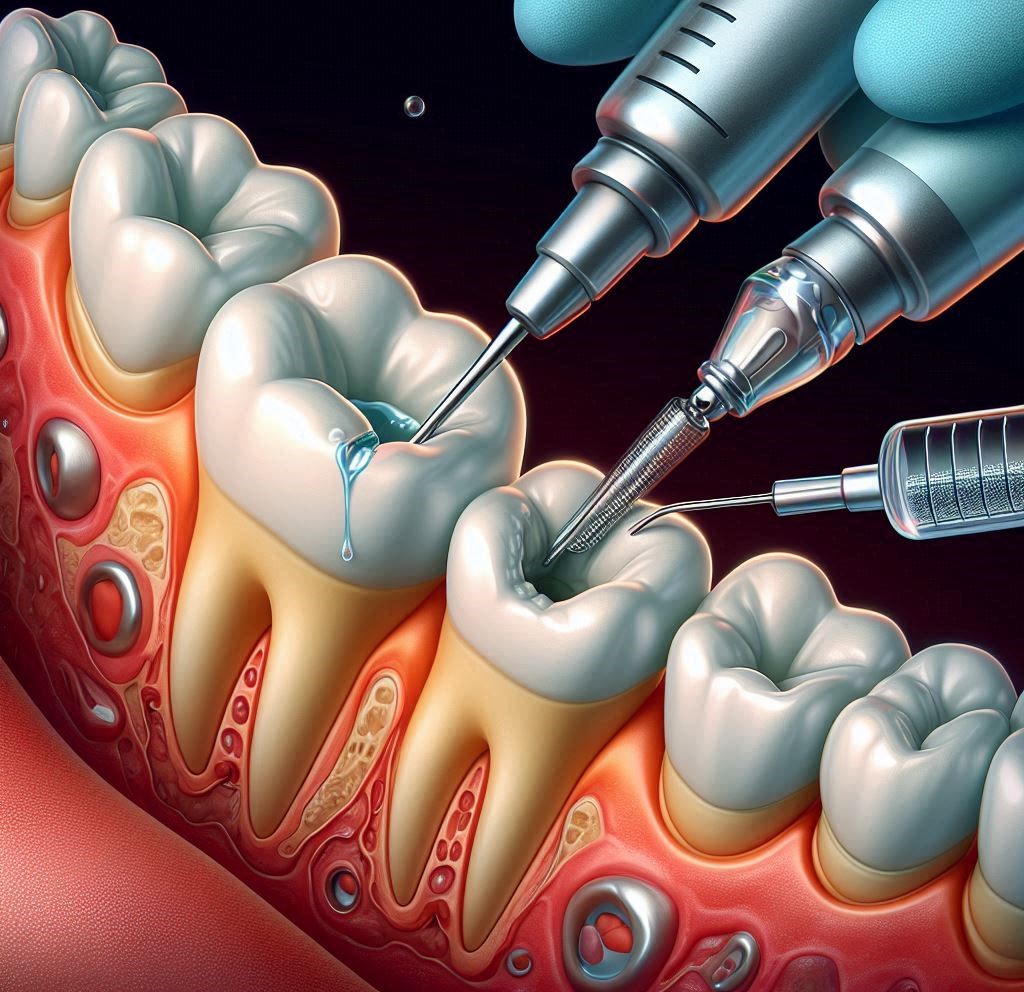Tooth decay, also known as dental caries, is one of the most prevalent dental issues worldwide. It occurs when harmful bacteria in the mouth metabolize sugars and produce acids that break down the enamel of the tooth. The result is a cavity or hole that requires dental intervention. Typically, a filling is used to restore the damaged tooth. Fillings work by “filling in” the decayed area after cleaning out the infected tooth tissue.
However, not all cavities are created equal, and there are instances when a filling won’t suffice to restore a tooth to its original strength and appearance. In such cases, more advanced restorative options become necessary.
Restorative dentistry refers to the branch of dentistry that focuses on replacing or repairing damaged or missing teeth. It encompasses various techniques and materials used to restore the form and function of a tooth. While fillings are the go-to solution for minor cavities, there are several other options for more complex dental issues.
An In-Depth Look at Fillings: Materials, Methods, and Limitations
Fillings have been a cornerstone of restorative dentistry for decades. Their primary role is to fill cavities created by tooth decay. Fillings can also be used to repair cracked or fractured teeth caused by trauma. Below, we’ll dive into the types of filling materials and the processes involved.
Materials Used for Fillings:
- Amalgam (Silver Fillings):
- Composition: Amalgam is made from a mixture of silver, mercury, tin, and copper. It’s durable and ideal for restoring back teeth where the pressure from chewing is highest.
- Advantages: Strong, cost-effective, and long-lasting (up to 15 years).
- Disadvantages: The silver color doesn’t blend well with natural teeth, and mercury content, though safe in small amounts, has raised concerns in some patients.
- Composite Resins (Tooth-Colored Fillings):
- Composition: Made from a blend of plastic and glass particles, composite resins can be color-matched to the natural shade of your teeth.
- Advantages: Aesthetically pleasing and ideal for visible teeth.
- Disadvantages: Less durable than amalgam and prone to wear over time, especially in large fillings.
- Ceramic Fillings:
- Composition: Made from porcelain, ceramic fillings are incredibly durable and natural-looking.
- Advantages: Highly aesthetic and resistant to staining.
- Disadvantages: More expensive and require more tooth removal than composite resins.
- Gold Fillings:
- Composition: Made from a gold alloy, these fillings are extremely durable and wear-resistant.
- Advantages: Long-lasting and highly resistant to corrosion.
- Disadvantages: Costly, and their appearance doesn’t blend well with natural teeth.
The Filling Process:
- Diagnosis and Preparation: The dentist will examine the tooth and take X-rays to assess the extent of the decay. If a filling is recommended, the decayed portion of the tooth is removed.
- Filling Placement: After cleaning out the cavity, the dentist will place the filling material into the cavity and harden it using light or air pressure, depending on the material.
- Final Shaping: The filling is shaped to match the natural contours of the tooth for optimal function and appearance.
Limitations of Fillings:
- Size and Durability: While fillings work well for smaller cavities, large cavities often need more support, making alternatives like crowns or inlays necessary.
- Wear and Tear: Fillings, particularly composite resins, may wear down over time, especially in high-pressure areas like the molars.
- Cosmetic Concerns: Although tooth-colored fillings are an option, they may not match the color of teeth perfectly, especially when placed in larger cavities.
Why Fillings Aren’t Always Enough: Scenarios that Require Alternatives
While fillings can restore a tooth’s functionality, there are numerous scenarios where fillings might not suffice. These situations generally involve more extensive decay, fractures, or teeth that require significant restoration to prevent further damage.
- Large Cavities or Decay: Large cavities can compromise the structural integrity of the tooth. A filling might not be able to provide the necessary strength for the tooth to function properly, particularly in the molars, which bear the brunt of chewing pressure. In these cases, a crown may be more appropriate.
- Significant Fractures or Chips: If a tooth is cracked or chipped, a filling won’t be enough to restore its shape or function. Crowns, onlays, or veneers might be needed to repair the tooth.
- Teeth with Root Damage: If the decay has reached the pulp of the tooth (the inner soft tissue), it may lead to an infection or abscess. In such cases, a root canal followed by a post-core restoration and crown would be necessary.
- Teeth with Extensive Wear: Teeth that have been worn down due to grinding (bruxism) or acid erosion may require more robust restorations like crowns or onlays to restore their shape and function.
- Cosmetic Concerns: Fillings may be functional, but they might not be ideal for improving the aesthetics of a tooth, especially if it’s located in a visible area of the mouth. Crowns, veneers, or inlays offer better cosmetic outcomes.
Dental Crowns: A Detailed Guide
A dental crown is a cap that covers a tooth to restore its shape, size, strength, and appearance. Crowns are often recommended when a tooth is significantly damaged or decayed.
Crown Materials:
- Porcelain Crowns: Most commonly used for visible teeth, porcelain crowns mimic the natural color and translucency of natural teeth. They provide the best aesthetic outcome but can be less durable than metal crowns.
- Porcelain-Fused-to-Metal (PFM): These crowns have a metal base with a porcelain exterior, offering both durability and aesthetic appeal.
- Gold Crowns: Gold is the most durable material, making it ideal for back teeth that endure high pressure. However, they are not aesthetically pleasing for front teeth.
- Resin Crowns: These crowns are tooth-colored but tend to wear down faster than porcelain crowns.
When to Consider Crowns:
- If a large filling is required.
- If the tooth has cracked or fractured.
- After root canal therapy to protect the remaining tooth structure.
- For teeth with extensive decay or wear.
- To improve the appearance of a discolored or misshapen tooth.
The Process of Getting a Crown:
- First Appointment: The dentist prepares the tooth by removing any decayed or damaged tissue and shaping it to fit the crown. An impression of the tooth is taken to create a custom crown.
- Temporary Crown: While the permanent crown is being fabricated, a temporary crown is placed to protect the tooth.
- Second Appointment: Once the crown is ready, the temporary crown is removed, and the permanent crown is placed and adjusted for a perfect fit.
Pros and Cons of Crowns:
- Pros: Durable, restores tooth function, improves appearance, long-lasting.
- Cons: Expensive, requires removal of significant tooth structure, can be time-consuming (two visits).
Inlays and Onlays: The Next Step in Restoration
Inlays and onlays are restorations that are typically used when a filling won’t suffice but the damage isn’t severe enough to require a crown.
Differences Between Inlays and Onlays:
- Inlays: These are used to fill cavities that are confined to the area within the cusps of the tooth.
- Onlays: Onlays are larger restorations that extend over one or more cusps of the tooth.
The Process of Getting Inlays and Onlays:
- Tooth Preparation: The decayed or damaged portion of the tooth is removed, and the cavity is cleaned.
- Impressions: Impressions are taken to create a custom restoration.
- Temporary Restoration: A temporary restoration may be placed until the permanent inlay or onlay is ready.
- Placement: The permanent inlay or onlay is cemented into place and adjusted.
Pros and Cons of Inlays and Onlays:
- Pros: More conservative than crowns, highly durable, aesthetically pleasing, restore more tooth structure than fillings.
- Cons: Requires more tooth removal than fillings, costlier than simple fillings.
Dental Veneers: Aesthetic Solutions for Minor Damage
Veneers are thin shells of porcelain or composite resin placed over the front surface of teeth to improve appearance.
Types of Veneers:
- Porcelain Veneers: Provide a natural look and are highly durable.
- Composite Veneers: A more affordable option, though not as durable as porcelain.
When Veneers Are Used:
- For teeth with minor chips, cracks, or discoloration.
- To close gaps or address slight misalignments.
Advantages and Disadvantages of Veneers:
- Pros: Aesthetic enhancement, minimal tooth preparation, long-lasting.
- Cons: Not suitable for extensive decay or damage, can be costly, potential for chipping or cracking.
7. Root Canals and Post-Core Restorations: Addressing Severe Damage
What is a Root Canal?
A root canal is a dental procedure performed when the pulp (the soft inner tissue of the tooth) becomes infected or inflamed, usually due to deep decay or trauma. The goal of the procedure is to remove the infected pulp, clean out the inside of the tooth, and then seal it to prevent future infection. If left untreated, an infected tooth pulp can lead to more serious problems, including abscesses, severe pain, and tooth loss.
Indications for a Root Canal:
- Severe Tooth Decay: When decay reaches the tooth’s pulp.
- Infection or Abscess: Pulp infection can result in swelling, pain, and abscess formation.
- Trauma or Injury: A fractured tooth may cause pulp damage, requiring a root canal.
- Chronic Tooth Pain: Persistent pain from a deep cavity may be alleviated through a root canal.
The Root Canal Process
- Diagnosis and Imaging: The dentist will take X-rays to assess the extent of the decay and infection in the tooth. If the pulp is infected, a root canal is typically recommended.
- Anesthesia: Local anesthesia is administered to ensure the procedure is pain-free. In some cases, sedation may be used for patients with anxiety.
- Pulp Removal: The dentist creates a small opening in the top of the tooth to access the pulp. Using specialized instruments, the infected pulp tissue is removed.
- Cleaning and Shaping: Once the pulp is removed, the space inside the tooth is cleaned, disinfected, and shaped to make room for the filling material.
- Sealing: The space left by the pulp is sealed with a rubber-like material called gutta-percha, which helps prevent future infection.
- Final Restoration: After the root canal is complete, the tooth will need to be restored with a post-core restoration and a crown. The post-core helps reinforce the tooth and provides structure for the crown to sit securely.
Post-Core Restorations:
A post-core restoration is used after a root canal treatment to rebuild the structure of the tooth, especially if there’s significant damage or if much of the tooth has been removed. This restoration typically involves placing a metal post or core inside the tooth to provide strength and support, allowing a crown to be placed on top.
Advantages of Root Canals with Post-Core Restorations:
- Saves the Tooth: The main benefit of a root canal is that it can save a tooth that would otherwise need to be extracted.
- Pain Relief: Root canals effectively eliminate the pain caused by an infected tooth pulp.
- Long-Term Solution: With proper care, teeth treated with root canals can last for many years, even a lifetime.
Disadvantages of Root Canals:
- Multiple Visits: The procedure often requires two or more visits to the dentist, depending on the severity of the infection.
- Weakening of the Tooth: After the pulp is removed, the tooth may become more brittle and prone to fractures, which is why post-core restorations and crowns are necessary.
- Potential for Re-infection: Although rare, there is a chance that bacteria can re-enter the tooth, necessitating re-treatment or extraction.
8. Other Less Common Alternatives: Bridges, Dentures, and Implants
While crowns, inlays, onlays, and veneers are common alternatives to fillings, there are other restorative options that may be used when teeth are lost or severely damaged.
Dental Bridges:
A dental bridge is used to replace one or more missing teeth. A bridge consists of one or more artificial teeth (pontics) anchored to adjacent teeth (abutments) using crowns. Bridges are often used when a patient has lost a tooth due to decay, injury, or disease.
Types of Bridges:
- Traditional Bridges: These are the most common and involve using crowns on adjacent teeth to support the pontic.
- Cantilever Bridges: Used when there are teeth only on one side of the missing tooth. The pontic is anchored to just one adjacent tooth.
- Maryland Bridges: A more conservative option, Maryland bridges use metal or porcelain wings to attach the pontic to the adjacent teeth without crowns.
Advantages of Bridges:
- Restores Function: Bridges can restore the ability to chew and speak properly.
- Prevents Shifting: A bridge can prevent neighboring teeth from shifting into the gap left by a missing tooth.
- Aesthetic Improvement: Bridges help restore the smile and appearance of the patient.
Disadvantages of Bridges:
- Requires Alteration of Adjacent Teeth: The neighboring teeth often need to be filed down to accommodate crowns for the bridge.
- Less Durability than Implants: Bridges may not last as long as dental implants and can require replacement over time.
- Risk of Decay: The natural teeth supporting the bridge can still be susceptible to decay, which may compromise the entire bridge.
Dentures:
Dentures are removable appliances used to replace missing teeth. They can be partial (replacing some missing teeth) or full (replacing all missing teeth).
Types of Dentures:
- Complete Dentures: Used when all teeth are missing in an arch.
- Partial Dentures: Used when only some teeth are missing. These are often attached to remaining natural teeth using metal clasps or other attachment systems.
Advantages of Dentures:
- Cost-Effective: Dentures tend to be more affordable than implants or bridges.
- Quick Solution: Dentures can be made relatively quickly, providing an immediate solution for missing teeth.
- Restores Appearance: Dentures restore facial aesthetics by replacing missing teeth.
Disadvantages of Dentures:
- Less Comfortable: Dentures can feel bulky or uncomfortable, especially when first worn.
- Requires Maintenance: Dentures require regular cleaning and adjustments to maintain their fit and function.
- Not as Durable: Dentures may need to be replaced every few years, as they wear down or lose their fit over time.
Dental Implants:
A dental implant is a titanium post surgically placed into the jawbone to replace a missing tooth’s root. Once the implant fuses with the bone (a process called osseointegration), a crown is placed on top, mimicking the appearance and function of a natural tooth.
Advantages of Implants:
- Long-Term Solution: Implants can last for decades with proper care and can even last a lifetime in some cases.
- Preserves Bone: Implants stimulate the jawbone and prevent bone loss that typically occurs after tooth loss.
- Function and Appearance: Implants look, feel, and function like natural teeth, making them the most aesthetic and functional choice for tooth replacement.
Disadvantages of Implants:
- Surgical Procedure: The implantation process involves surgery, which carries inherent risks and requires time for healing.
- Cost: Implants are one of the more expensive restorative options.
- Time-Consuming: The implant process can take several months to complete, from placement to full integration.
Factors to Consider When Choosing a Dental Restoration
When choosing an alternative to a dental filling, several factors must be taken into account. These include:
- Cost Considerations: Some restorative options are significantly more expensive than others. For example, crowns and implants tend to be more costly than fillings or partial dentures. However, they may offer better long-term value, particularly if longevity and durability are priorities.
- Longevity and Durability: The expected lifespan of the restoration is crucial. Crowns, inlays, onlays, and implants tend to last much longer than fillings, especially when it comes to molars or teeth that experience heavy wear. Fillings, particularly composite fillings, may need to be replaced more frequently.
- Aesthetic Needs: If the restoration is for a front tooth, aesthetic considerations are important. Materials like porcelain crowns, veneers, or composite resins are more suitable for visible areas because they match the natural tooth color.
- Tooth Location: The location of the tooth in the mouth can influence the decision. For instance, gold crowns are highly durable but not aesthetically appealing for front teeth. Porcelain or ceramic crowns are better suited for visible areas, while metal or PFM crowns are often used for back teeth.
- Personal Preferences: Some patients may prioritize cost and simplicity, while others may be more concerned about appearance and longevity. A dentist can help guide the decision-making process based on the patient’s preferences and oral health needs.
Post-Treatment Care and Long-Term Considerations for Restorations
Proper care is crucial to ensuring the success and longevity of any dental restoration. After receiving crowns, veneers, implants, or other restorative treatments, patients should follow their dentist’s instructions regarding post-treatment care, which may include:
- Avoiding Hard Foods: Immediately after treatment, avoid chewing hard foods that may damage or dislodge the restoration.
- Good Oral Hygiene: Continue practicing good oral hygiene, including brushing, flossing, and using mouthwash to prevent decay around the restoration.
- Regular Dental Visits: Routine dental check-ups are essential to monitor the condition of restorations and ensure the surrounding teeth and gums remain healthy.
- Avoiding Teeth Grinding: For those who grind their teeth (bruxism), wearing a nightguard can protect restorations from wear.
The Future of Restorative Dentistry: Innovations and Trends
The field of restorative dentistry is constantly evolving, with new materials and technologies emerging that offer better outcomes for patients. Some exciting trends include:
- 3D Printing: 3D printing is revolutionizing dental restoration, allowing for faster and more precise fabrication of crowns, bridges, and dentures.
- Biomaterials: Advances in biomaterials aim to create restorations that more closely mimic natural teeth, both in appearance and function.
- Regenerative Dentistry: Research into stem cell therapies and tooth regeneration may one day allow dentists to repair damaged teeth at a cellular level, reducing the need for traditional restorative treatments.
Conclusion
In conclusion, while dental fillings remain a go-to solution for minor tooth decay, they are not always sufficient for more extensive damage. In these cases, alternatives like crowns, inlays, onlays, veneers, bridges, dentures, and implants can provide superior functionality, aesthetics, and durability.
The choice between these alternatives depends on several factors, including the extent of the damage, the location of the tooth, cost considerations, personal preferences, and long-term needs. Each restorative option has its pros and cons, and the best solution for you will depend on your unique oral health situation.
Consulting with a skilled dentist is essential to making an informed decision. With the right treatment, you can restore your smile and protect your oral health for years to come. As restorative dentistry continues to evolve, patients can look forward to even more effective and aesthetic solutions for maintaining a healthy, beautiful smile.
SOURCES
Bergen, D. A. (2019). Restorative materials in dentistry: An overview. Journal of Dental Materials, 45, 45-60.
Chen, C. H., Liu, X., & Zhang, M. Y. (2021). Dental crowns and their impact on tooth restoration: A clinical perspective. International Journal of Dentistry and Oral Science, 18, 1015-1025.
Dawson, D. V. (2020). Understanding restorative options for damaged teeth: From fillings to implants. Dental Clinics of North America, 64, 503-522.
Ellis, R. G., Simmons, J. R., & Lopez, C. R. (2018). Inlays and onlays in modern restorative dentistry. Journal of the American Dental Association, 149(8), 723-730.
Frazier-Bowers, S. A., Richman, P. I., & Kahn, H. P. (2022). Advancements in dental implant technology: A comprehensive review. Journal of Periodontal Research, 57, 209-218.
González-Méijome, J. M., Santos, T. R., & Alvarez, D. D. (2017). Material science in dental restorative practices: From ceramics to biomimetic materials. Journal of Prosthetic Dentistry, 118, 1003-1011.
Lind, R. L. (2021). The evolving role of dental veneers in cosmetic and restorative dentistry. Journal of Esthetic and Restorative Dentistry, 33, 193-202.
Miller, S. J., Garcia, J. M., & Brown, W. E. (2020). Crowns, bridges, and dentures: Comparative effectiveness and materials choice. International Journal of Prosthodontics, 33, 453-460.
Nasser, M. R., & Mitchell, S. L. (2019). Root canal treatment: A review of techniques and post-treatment care. Dental Clinics of North America, 63, 729-745.
Thomas, R. K., Tremont, R. A., & Lopes, J. A. (2021). Aesthetic restorations and patient satisfaction in modern dentistry. Journal of Clinical Dentistry, 32, 112-119.
Walker, M. B. (2018). Comparing filling materials: A study of longevity and performance. Journal of Dental Research, 97(3), 435-440.
HISTORY
Current Version
February 19, 2025
Written By:
SUMMIYAH MAHMOOD




